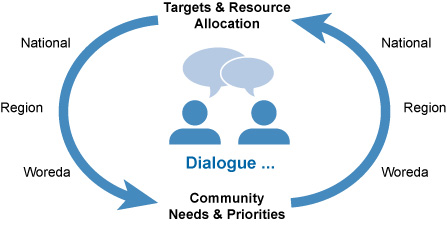14.5 Planning framework
Planning is not just a one-off activity in the OWNP. There is a continuous planning cycle in place to ensure the overall plans described in the previous sections are enacted. This planning activity takes place at all levels of the WASH management system, from federal down to kebele levels and involves all stakeholders. This activity follows a consistent framework that was established to harmonise the plans and budgets of all the implementing agencies into one plan and one budget.
There are a number of different types of plans included in the framework. This starts with Strategic Plans and Annual Plans at national, regional/zonal and woreda levels.
Strategic Plans comprise three elements in line with the planning process we have described above. Strategic Plans include the targets that are to be achieved, the baseline that states the current situation and resource mapping, which identifies the financial resources that are available (POM, 2014). To update strategic plans and ensure they continue to be relevant, the targets, baseline and resources are adjusted regularly to reflect the changing situation. For example, after two or three years of any ongoing project, some progress should have been made so the baseline would have changed, there may be more or less finance available, and the targets may need adjusting. A strategic plan should reflect these changes so it remains useful.
Once Strategic Plans are finalised, the next step is to prepare Annual WASH Plans. These translate the broader objectives and priorities of the Strategic Plan into practical activities and detailed budgets. Annual WASH Plans should be prepared in consultation with stakeholders including relevant government institutions, development partners, NGOs and, at woreda and kebele levels, the community. Both Strategic and Annual plans need to be reviewed and approved by the WASH Steering Committee at each level.
Annual WASH planning is done in two stages through the course of each year:
- Core Plans: includes physical and financial plans and provide the basis for building detailed Annual WASH Work Plans. Physical plans describe the work to be done and financial plans describe the costs and budget allocation.
- Annual WASH Work Plans: include specific details of activities, assignments, schedules and proposed expenditure from all sources.
Do you remember the discussion in Study Session 7 about vertical relationships in the OWNP organisational structure? The planning process demonstrates these vertical relationships and involves a dialogue between implementers at different levels, both upwards and downwards. Core planning is essentially a top-down process in which higher levels set out their targets and allocations for the forthcoming planning period and hands them down to lower levels. Annual planning, on the other hand, should be bottom-up. Communities identify their needs, establish their priorities and plan their activities. As plans are consolidated at each level the implementers at the next higher level incorporate them in their plans and calculate what they need to do in terms of activity and budget expenditure to support the plans of the lower level (WIF, 2011). This process is illustrated in Figure 14.4.

The development of Core Plans and Annual Work Plans takes place in an annual cycle that follows the same pattern each year. Core planning takes place from August through to November and annual work planning from December to February. This is part of a much larger and more complex sequence of events in the annual planning and budgeting cycle that links the various levels according to the vertical relationships described above. Plans and budgets are consolidated at the different levels and submitted for review and approval. (You read about this process in Study Session 12.) Budgeting is tied in to the annual contributions from development partners that set the budget ceilings each year, the resource mapping exercise that confirms financial resources available from all possible sources, and the revised targets. In this way, the plans are revised every year so they correspond to the needs and priorities, and the available resources in order to make progress towards achieving the desired targets.
14.4 Plans for other components
